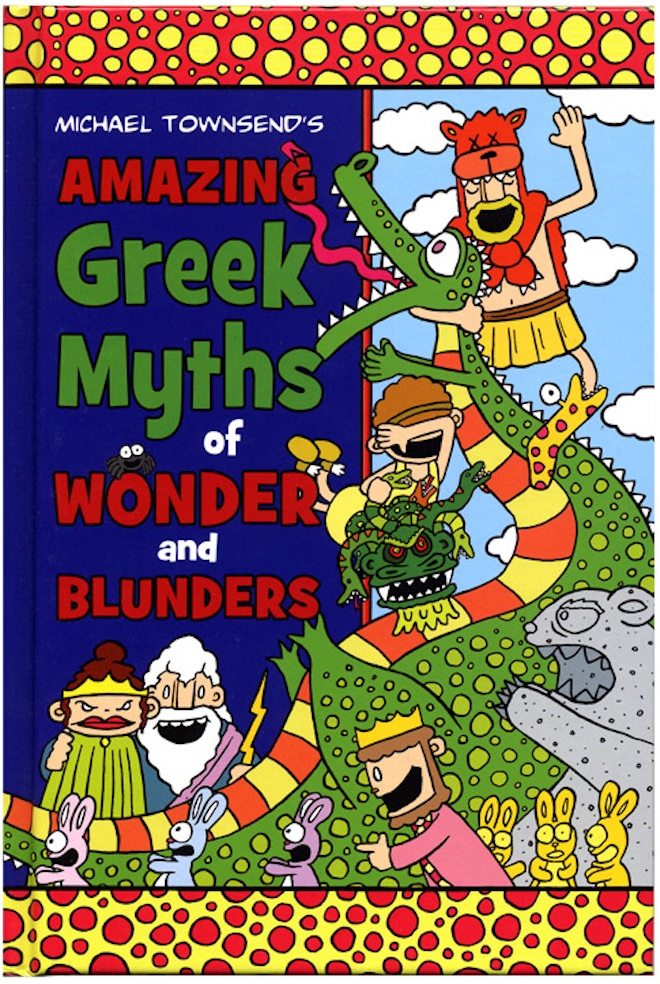
With the summer blockbuster Percy Jackson: Sea of Monsters opening in theaters today, we’ve been Greeking out in our house in preparation. All three of my kids enjoyed the first big screen installment from 2010, Percy Jackson and the Olympians: The Lightning Thief, and they are eager to slap some wings on their ankles like Hermes and hurry the whole family to the closest matinee.
Young readers who have devoured all five of the Percy Jackson and the Olympians books can move on to The Heroes of Olympus, which at current tally offers three books out of an expected five.
But what else is out there for myth hungry young readers? Plenty.
There are the classics like D’Aulaires’ Book of Greek Myths and the tongue-in-cheek Oh My Gods!, both of which are included in a rundown of recommended Greek mythology titles listed below. And George O’Connor’s Olympians graphic novel series from First Second is not to be missed.
However, one of the best primers to introduce young readers to Greek mythology is Michael Townsend’s hilarious graphic novel Amazing Greek Myths of Wonder and Blunders (Dial Books for Young Readers, 2010).
Illustrated in deep colors in a comic-book style, Townsend’s Amazing Greek Myths uses humor and a silly tone to appeal to young readers. Despite jokes and running gags involving sheep, Townsend stays true to the essence of each of the nine Greek myths included in the book, from Pandora to Persephone, King Midas to Hercules.
I interviewed Townsend about his book, what he finds inspiring in Greek mythology, and why his graphic novel appeals to certain young readers.
GeekMom (Kate Hannigan): Your book offers a fun and engaging introduction to Greek mythology. And when you consider the blood, gore, and questionable behavior of the gods and mortals, it presents the material in an age-appropriate way. What made you want to create a book like this for young readers?
Michael Townsend: The genesis of this book actually began when an editor at Penguin mentioned that she wanted to do a fun Greek myth book for early readers in a comic-book type way. Since nobody was buying my dummy book about a dog without any legs named Muffin and a separate story about a pie-stealing monkey, I became interested in making something Greek-myth related to show her.
I got to work making a one-chapter sample of what I envisioned for this kind of project, and boom! I had a book deal. (Just kidding; it’s never boom.) After many months of back and forth, and a fun lunch, an actual book deal evolved. And I began working on what would become my Amazing Greek Myths of Wonder and Blunders book!
GM: Do you have a background in Greek mythology or simply an interest in it? How familiar were you with the stories before you put pen to paper?
MT: I read Greek myths in school when I was younger, but I never really got into them that much (I vaguely remember that I found them boring). I had a few good friends who felt differently. They would read through the Iliad or The Odyssey almost every week and were confused why people thought this weird. When I began this project, I really didn’t remember anything that I had learned. And I actually found myself really enjoying re-learning about Greek mythology. I don’t know why I found them boring when I was younger! But I hope that my book will help introduce kids early on to the fun world of mythology and the fact that it is not boring. It’s fun and weird and worth learning about!
GM: How challenging was it to adapt the stories for children? Can you talk about your creative process?

MT: For the Greek myth project, I would just read through the collections of the famous myths and then pick the ones I thought would be fun to re-tell. I was looking for the myths that were simple enough for the format I was working in (simple sentences and only 12-22 pages per story) and that had the potential to be funny. Next, I would spend a lot of time re-reading the story, making sketches, trying to break down the story to its simplest form, and writing down gag ideas. Then, I would often just sit with the material and think. Once I had some character sketches I liked and a simple outline, I began writing and re-writing the story while inserting silly gags. After playing around with a bunch of different ideas for a while, I would begin to sense what was working and what wasn’t, and a finished, short, silly story started to form.
GM: The Percy Jackson books and movies have created an excitement around Greek mythology. Have you felt the Percy effect with your book?
MT: I think that I got a lot of invites to do school talks and bookstore visits because of the popularity of the Percy Jackson books and new interests in Greek mythology. And I bet it helped with sales too, but I’m just not sure how much.
GM: Keeping track of Zeus’s vast family can be confusing. But your book helps young readers get to know particular gods, goddesses, and mere mortals. What did you hope to accomplish with the book? What do you hope your readers take away from it?
MT: My main goal was that I wanted to make kids laugh! I have a soft spot for reluctant readers, and funny, silly cartoons are a good way to suck a reluctant reader in! My second goal was to make a book that, when a kid finished reading, he or she would be excited to keep reading and learning more about the world of Greek mythology.
GM: Who is your favorite god or goddess, or your favorite myth?
MT: When I was doing the research for this book, I read and re-read a lot of what you would expect (Ovid’s Metamorphoses, Edith Hamilton’s mythology book and Bulfinch’s mythology collection, etc.). But I also (mostly for fun) read a bunch of books that alluded to mythology in one way or another. One of those books was C.S. Lewis’s Till We Have Faces. It is a fantastic story where Lewis reworks the myth of Cupid and Psyche. It’s hard to explain why it’s so good, but it is. And for anyone who enjoys Greek mythology, they will love this book too. It’s beautiful in a sublime way.
GM: What will we see next from you? Any more Amazing Myths on the horizon?
MT: I would like to do more Greek mythology stuff or even some Norse mythology in the future. But I am currently working on a book that is all about different American inventors. I’m still in the writing stage, so I’m not in a great place to say more except that I’m excited and nervous — as I always am when creating.
More Books for Your Greek Geeks
Besides Townsend’s graphic novel, there are plenty of Greek mythology books lining the shelves of your local bookstore or library. But slogging through the list can be, well, a Herculean task. Here are some other kid-tested titles for your Greek geeks to explore.
Oh My Gods! A Look-it-Up Guide to the Gods of Mythology (Mythlopedia), by Megan E. Bryant (Franklin Watts, 2009)
The Mighty 12: Superheroes of Greek Myth, by Charles R. Smith, illustrated by P. Craig Russell (Little, Brown Books for Young Readers, 2008)
D’Aulaires’ Book of Greek Myths, by Ingri d’Aulaire and Edgar Parin d’Aulaire (Doubleday Books for Young Readers, 1962)
The Beautiful Stories of Life: Six Greek Myths, Retold, by Cynthia Rylant, illustrated by Carson Ellis (HMH Books for Young Readers, 2009)
Treasury of Greek Mythology: Classic Stories of Gods, Goddesses, Heroes & Monsters, by Donna Jo Napoli, illustrated by Christina Balit (National Geographic Children’s Books, 2011)
Stories of Sun, Stone and Sea, by Sally Pomme Clayton, illustrated by Jane Ray (Frances Lincoln Children’s Books , 2012)





